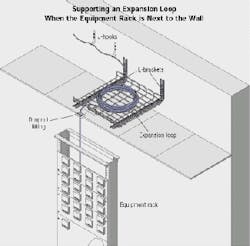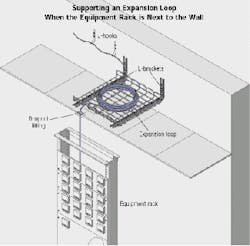Protection and support of expansion loops
problem
In most applications, expansion loops are attached to the J-hook or ring, and dangle down onto the ceiling tiles. Cable in the expansion loops may be damaged if not properly protected or given sufficient inline support.
solution
When approaching the location for your expansion loop, replace the J-hook or ring with a 2 to 3-foot section (depending on the number of loops being secured) of 24-inch-wide cable tray. You can mount the tray to the wall or suspend it from the ceiling, according to the location of the equipment rack. In this example, the equipment rack is next to the wall. A small tray section will provide the inline support, plus provide a location where your expansion loop can be safely and securely located.
procedure
- Determine how your expansion loop platform should be supported. If your equipment rack is next to the wall, bolt two L-brackets with an appropriate anchor device (i.e., sheet rock anchor, concrete anchor, wood screw). Your tray section will require two supports.
- Cut a section of the 24-inch-wide tray to support the expansion loop and avoid leaving any sharp edges. If you want to secure more loops, cut a longer section of tray. Also, you have the option to choose different depths of cable tray if your cable volume requires it. Choose the depth based on fill rate and the number of cable.
- Lay the tray section across the two L-brackets and fasten them together with clips, sections of wire, or washers with threaded bolts. This will keep the tray from moving off the support.
- Finally, lay the expansion loop on the platform of tray. You may insert dropout fittings into the ceiling to control the radius of cable falling into the equipment rack.
The National Electrical Contractors Associa-tion (www.necanet.org) requires 50% fill rate on cable trays.
If your equipment rack is away from the wall or positioned in the center of the room, attach threaded rods to the ceiling support by using beam clamps (to I-beam-type ceiling system) or rod anchors (either wood or concrete), according to the ceiling type.
Terry McCraryis team manager of new product development at GS Metals Corp.-Flextray Division (Pinckneyville, IL); www.flextray.com

